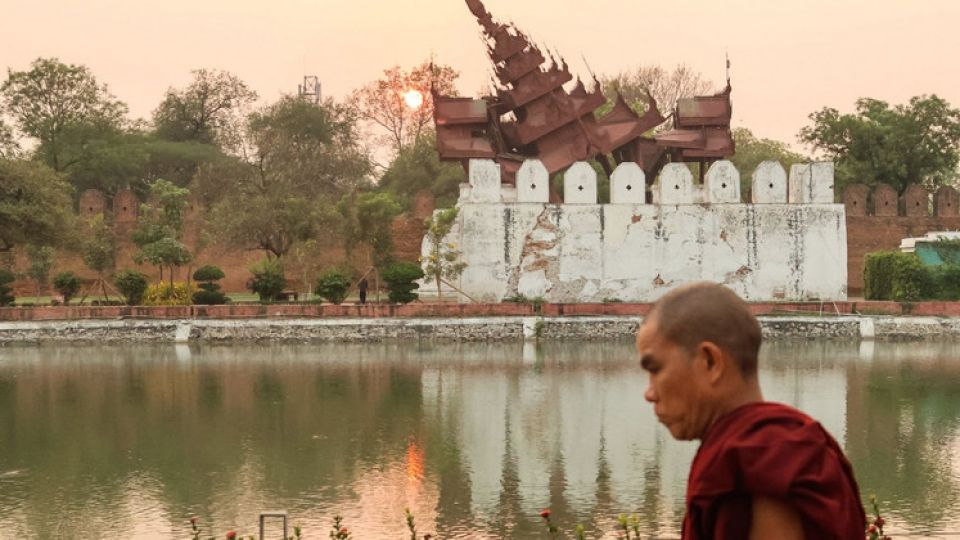May 2, 2025
DHAKA/ MANILA – Over a month after a massive earthquake rattled Myanmar, about 200,000 people, including scores of women and children, are displaced, of which about 42,000 people are living in 145 temporary shelters, per the April 14 data from the ASEAN Coordinating Centre for Humanitarian Assistance on Disaster Management (AHA).
This Asia News Network special report examines why the earthquake led to so much devastation, the current situation in quake-hit areas, and why earthquake preparedness is crucial.
An earthquake of catastrophic proportions
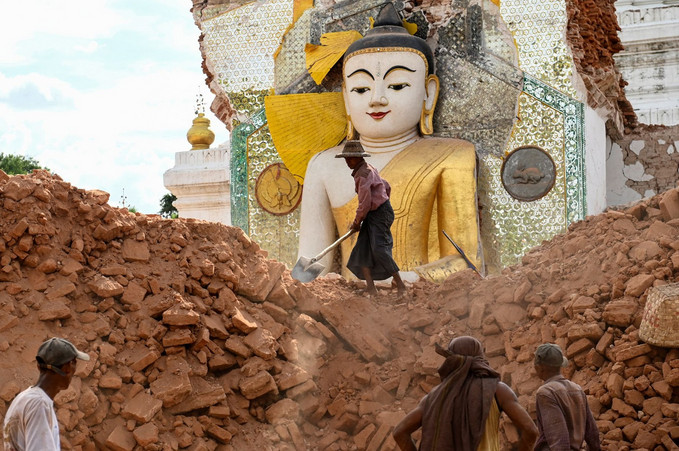
This photo taken on April 12, 2025 shows people clearing the debris around a damaged Buddha statue at Lawkatharaphu Pagoda in Inwa on the outskirts of Mandalay, following the devastating March 28 earthquake. PHOTO: AFP
To grasp the massive, destructive scale of the recent earthquake, one must understand the many factors that contributed to it, said Dr. Md. Sakawat Hossain, visiting scholar at the Department of Geological Sciences in the University of Missouri, Columbia, and professor at the Department of Geology at Jahangirnagar University, Dhaka.
He said further, “The magnitude of the earthquake, the depth of the origin, the location and position of the cities in reference to the fault orientation responsible for the earthquake, the composition of soil and the population density are all contributing factors to the impact of the major earthquake that has taken place in Myanmar.
“A 7.7 magnitude earthquake is quite major by itself. Paired with the shallow depth of the origin (about 10 km) and proximity to major cities Naypyidaw and Mandalay, it has caused the intense destruction we see today. For context, the amount of energy released during this earthquake was about 330 times that of the Hiroshima bombing.”
A worsening humanitarian crisis
The resulting conditions are nothing short of catastrophic. Food is difficult to come by and hygiene is a massive concern given the lack of access to reliable sources of clean water for drinking and washing. The temporary tents, per AHA, are constructed from materials that cannot withstand severe weather, such as heavy rain and extreme heat.
In the wake of the earthquake, the Association of Southeast Asian Nations (ASEAN), through a foreign ministers’ statement, said it strengthened relief and recovery efforts through the ASEAN Standby Arrangements and ASEAN Member States’ contributions, among other mechanisms. Foreign ministers also held a virtual emergency meeting, and the ASEAN Agreement on Disaster Management and Emergency Response, adopted in 2005, has provided the framework for action. An emergency assessment team was deployed within the critical 72-hour window, and relief supplies from regional stockpiles were mobilised.
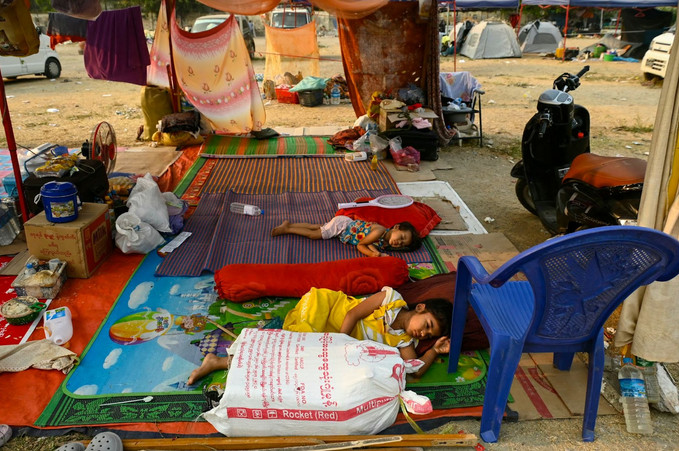
Children sleep in the open on the ground in Mandalay on April 4, 2025, following the March 28 earthquake. PHOTO: AFP
Individual countries, neighbouring and from farther afield, have also stepped up to give aid, be it through the deployment of rescue workers, paramedics, and even sniffer dogs—some of whom doubled as therapy dogs for survivors and their families, as reported by The Nation.
Reuters published a list of initial aid contributors three days after the quake, March 30, which included China, India, the United States, Vietnam, South Korea, Thailand, Russia, Japan, Singapore, Malaysia, Indonesia, the United Kingdom, New Zealand, the Philippines, and Taiwan.
The situation has been so dire that even neighbouring nations with complex relations with Myanmar have taken it upon themselves to send in relief and humanitarian aid. Despite significant challenges and strained relations between Myanmar and Bangladesh surrounding the Rohingya crisis, multiple rounds of relief, along with a humanitarian mission, were initiated by Bangladeshi authorities.

Indonesian Air Force troops and National Mitigation Agency officials prepare to load humanitarian aid from the Indonesian government for earthquake victims in Myanmar into a Hercules C-130 transport aircraft at Halim Perdanakusuma Air Base in Jakarta on March 31, 2025. PHOTO: AFP
According to The Daily Star, two transport aircrafts had been sent with 16.5 tonnes of emergency relief including dry rations, clean water, oral saline, tents, hygiene products and other essential products to Yangon on March 3.
A second batch of assistance was sent to Naypyidaw on April 1 which included an equipped medical team along with the relief supplies. By the end of the mission, the team had treated 885 patients and completed 17 complex surgeries.
In a more recent report on Reuters, however, the International Federation of Red Cross and Red Crescent Societies said on April 17 it had received “only a fraction of an emergency appeal for $100 million Swiss francs” to help in the recovery efforts. The amount is “a lot less than expected,” Alexander Matheou from the IFRC tells Reuters via video link in Mandalay.
According to a report released by the United Nations on its website on April 18, 4.3 million people urgently need clean water and sanitation. Malnutrition is a growing concern, particularly among children as food insecurity worsens. Education infrastructure and farmlands have also been hit hard. On top of this, the report adds, women and children have become more vulnerable.
Mariko Hall, communications officer of UNHCR Asia Pacific, told Asia News Network that 17.2 million people were affected by the earthquake. It also reduced homes, hospitals, and schools to rubble, she added, disrupting markets and essential services, including water and sanitation.
“The disaster has struck in the midst of an ongoing conflict that has persisted for over four years, worsening an already dire humanitarian crisis, and deepening hardships faced by both displaced and local communities,” she lamented.
Since day one, Hall shared, UNHCR has reached over 48,000 people so far, providing critical relief items like sleeping mats, blankets, tarpaulins, solar lamps and kitchen sets “so that people have somewhere to sleep, they have light, and they have utensils to cook with while recovery efforts are ongoing.”
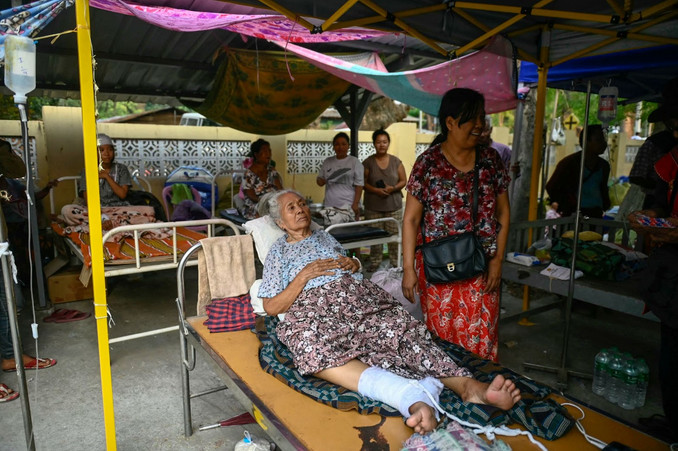
An elderly earthquake survivor rests on an outdoor bed in the compound of a hospital in Sagaing on April 2, 2025, five days after a major earthquake struck central Myanmar. PHOTO: AFP
For earthquake-affected communities, Hall said the most urgent needs include emergency shelter, core relief items – like solar lamps, tarpaulins, mosquito nets, tents, kitchen sets – safe drinking water, food, and healthcare. “Particularly ahead of the monsoon season, with risk of floods and landslides, shelter support is essential so that people have somewhere safe to live,” she added.
Hall also mentioned that UNHCR is strengthening access to protection services, such as the dissemination of safety messages, legal assistance, and psychosocial support for survivors, with targeted interventions for children, women, and people with disabilities.
Given the existing challenges on the ground, compounded by powerful aftershocks and heavy rains, Hall told ANN that to ensure rapid response, they had to reprioritise existing resources and dispatch emergency supplies from Yangon to assist survivors.
“Last week, a UNHCR-chartered flight – supported by Dubai Humanitarian – arrived in Yangon with assistance for a further 16,000 people,” she said. “As always, we are collaborating with UN agencies, international and national NGOs and other humanitarian and development partners, and coordinating our responses to ensure aid reaches those most in need.”
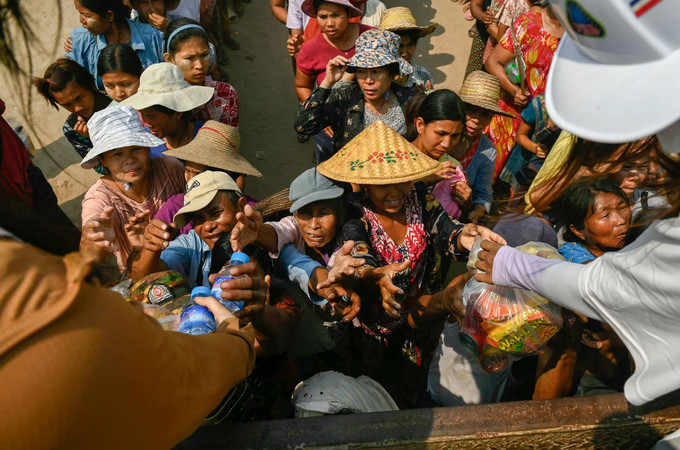
People reach up for food aid being distributed in Sagaing on April 3, 2025, following the March 28 earthquake. PHOTO: AFP
Hall said that UNHCR’s ability to deliver humanitarian aid and provide protection assistance depends in large part on the generous donations of individuals and the international community.
“UNHCR’s total funding requirements for Myanmar in 2025 is US$88.3 million to assist displaced people and their host communities,” she shared, adding that “As of the end of March, less than 20% of funding had been secured.”
“At this critical time, the people of Myanmar need the support of the international community more than ever.”
Urgency of earthquake preparedness
As of April 29, the quake has claimed 3,798 lives and left 5,106 injured and 106 missing, per a report on Eleven Media. The earthquake was so devastating that it necessitated rebuilding and relocation plans in the country’s capital Naypyidaw, The Nation reported. The capital’s urban layout is now under review, the article continued, with Senior General Min Aung Hlaing, Myanmar’s junta leader, announcing plans to redesign the city’s urban structure during a cabinet meeting held shortly after the quake.
With the sudden onset of such a devastating crisis, there have been speculations about whether this earthquake is an indicator of disasters that may repeat in the future within the region. Misinformation on social media has further exacerbated the collective panic among people about the possibilities of earthquakes and the ability of authorities to mitigate the impact of such disasters.
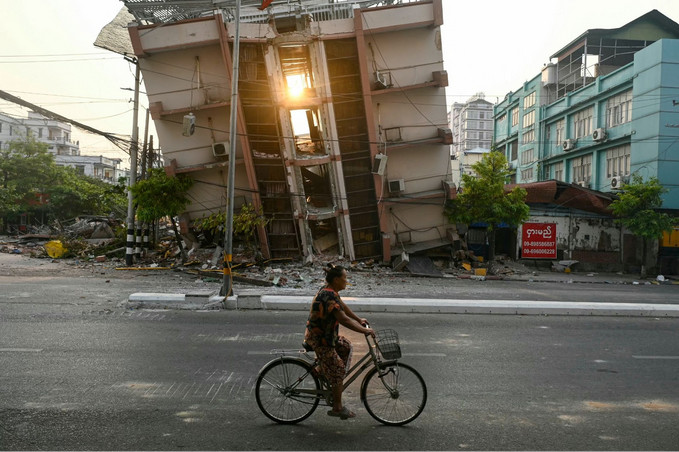
A woman rides her bicycle past a collapsed building in Mandalay on April 1, 2025, a few days after the deadly Myanmar earthquake. PHOTO: AFP
In this regard, Hossain told ANN, “Earthquakes are the only natural disasters that cannot be predicted even a few seconds in advance. There is no way to warn authorities and the public. Having said that, this region has many large-scale fault lines, of which many are quite active. This includes the Sagaing Fault which has experienced about nine major earthquakes in the past 100 years, the Chittagong Coastal Fault, the Main Frontal Thrust Fault, Dauki Fault, the Oldham Fault, the Madhupur Fault and the Sylhet Fault.”
“Most of these faults have recurrence intervals between 20-30 years and 200-500 years. These faults can impact India (specifically North and Northeast India), Bangladesh, Nepal, Bhutan, Thailand and, of course, Myanmar. Thus, I cannot say when or exactly where there can be an earthquake, but I can say that there is a looming threat to the region, and we must be prepared,” he added.
While analysing the possible risks of major earthquakes in the region, Hossain mentioned that a lot of major cities in South Asia, such as Mandalay, Naypyidaw, Bangkok, Silchar, Kathmandu, Kolkata, and Dhaka, are built on flatlands and soft sediments.
Earthquakes in flatlands and areas with soft sediment, like delta and basin regions, can result in unique and potentially damaging effects, including liquefaction and ground deformation. Soil liquefaction is a phenomenon where saturated soil loses its strength and stiffness, transforming from a solid to a liquid-like state, which increases the odds of higher damages to the region experiencing the earthquake, including possible subsidence and landslides.
Thus, it is crucial for nations, especially those with densely populated areas and cities, to make necessary arrangements to not only prepare for the possibility of an earthquake and mitigate the possible impacts of such disasters, but also to spread awareness to the public about what can be done and how they can be prepared themselves.
“Authorities must increase their knowledge and vigilance over earthquake hazard assessment capacity, and by investing in equipment and stations that would observe overall seismic activities within the region, giving them the scope to collect as much information as possible.
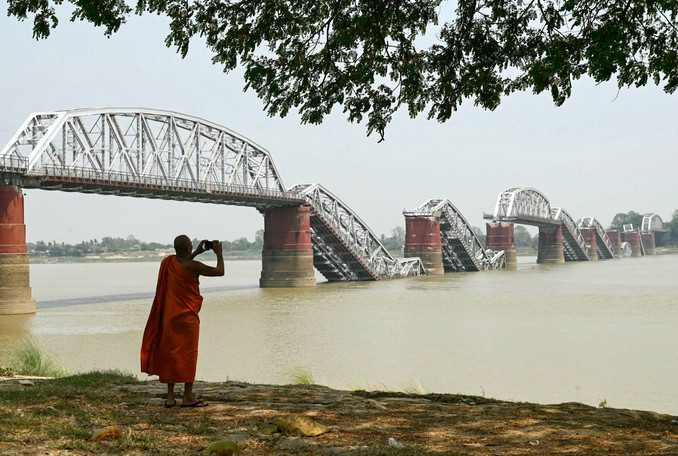
A monk takes photo on the banks of the Irrawaddy River in front of the collapsed Ava Bridge, also known as the Inwa Bridge, in Sagaing on April 3, 2025, after the March 28 earthquake struck central Myanmar. PHOTO: AFP
“Reducing vulnerabilities to power, water, gas and telecom networks is also an extremely important step for authorities, as these infrastructures often take the first hit. Investing in rescue equipment is also a must for each nation in this region,” Hossain said when highlighting some of the crucial steps required to manage and prepare for the possibility of major earthquakes.
“Policies and building codes must be updated and strictly implemented to ensure proper construction of earthquake-resistant establishments or infrastructures for all new projects. Authorities must also enforce retrofitting and other engineering measures for older constructions and buildings, allowing impending damage to be minimised,” he added.
He further mentioned, “There should be campaigns and training available to make people aware of what to do in case of such an emergency, and make it available in all educational institutes, at all levels and capacities, to better understand what the disaster is and how to keep themselves prepared for it.”
Companies, communities, and individuals can contribute to the UNHCR earthquake response in Myanmar through donate.unhcr.org/int/en/myanmar-situation.


